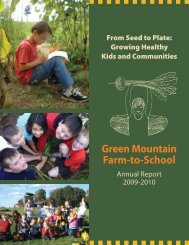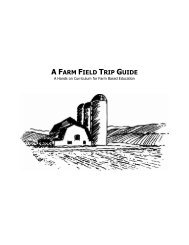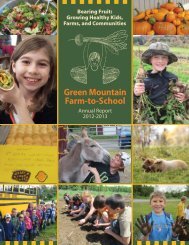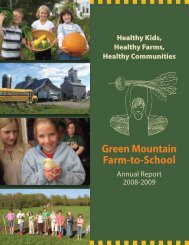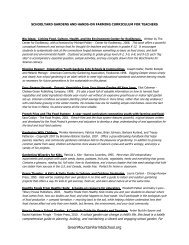A Guide to Starting a Composting Program in Your School - Green ...
A Guide to Starting a Composting Program in Your School - Green ...
A Guide to Starting a Composting Program in Your School - Green ...
You also want an ePaper? Increase the reach of your titles
YUMPU automatically turns print PDFs into web optimized ePapers that Google loves.
Regulations & Health Concerns<br />
When start<strong>in</strong>g up a compost<strong>in</strong>g program at your school people <strong>in</strong> the community, and<br />
possibly yourself, will have questions about the health and safety of the project.<br />
Familiarize yourself with the regulations and safety concerns before you beg<strong>in</strong>.<br />
Regulations<br />
Section 5-213 Item 34 of the Health Department’s code for Food safety <strong>in</strong>dicates that<br />
―Food waste may be disposed of by compost<strong>in</strong>g with the follow<strong>in</strong>g requirements:<br />
A. Compost sites cannot be <strong>in</strong> close proximity <strong>to</strong> the outer open<strong>in</strong>gs of a food<br />
service establishment.<br />
B. A compost site must be properly operated and kept free of <strong>in</strong>sects, rodents, and<br />
verm<strong>in</strong>.<br />
C. Compost sites cannot create a health hazard or nuisance <strong>to</strong> any food<br />
establishment or neighbor<strong>in</strong>g property owner.‖<br />
Health and Safety<br />
<strong>Compost<strong>in</strong>g</strong> can be a fun and educational experience that can <strong>in</strong>volve students, staff,<br />
and parents. To make it an educational environment, look <strong>in</strong><strong>to</strong> reduc<strong>in</strong>g potential risks.<br />
1. Protect those likely <strong>to</strong> be most sensitive. Involve the teachers, school nurse or<br />
physician, parents, and faculty/staff <strong>to</strong> discover any potentially susceptible students<br />
or staff. Protect the privacy of medical <strong>in</strong>formation, but determ<strong>in</strong>e who may have<br />
allergies, be immunocompromised or be prone <strong>to</strong> <strong>in</strong>fections that could make them<br />
sensitive <strong>to</strong> potential risks. Control exposure of these <strong>in</strong>dividuals by restrict<strong>in</strong>g who<br />
actually comes <strong>in</strong> contact with the compost. Other students or the teacher could<br />
feed the compost b<strong>in</strong> or take samples. Do not stir or otherwise disturb the pile or<br />
b<strong>in</strong> when people susceptible <strong>to</strong> <strong>in</strong>halation of allergens are nearby.<br />
2. If the temperature of the compost pile is properly ma<strong>in</strong>ta<strong>in</strong>ed (it says at a high<br />
temperature), the risk of pathogens is decreased. Be sure <strong>to</strong> moni<strong>to</strong>r temperatures<br />
and turn the pile frequently. For more <strong>in</strong>formation, see the fact sheet on Health &<br />
Safey Guidance for Small Scale <strong>Compost<strong>in</strong>g</strong> at:<br />
http://cwmi.css.cornell.edu/smallscaleguidance.pdf<br />
3. Turn<strong>in</strong>g the compost pile will release airborne particles and gases that can cause<br />
symp<strong>to</strong>ms <strong>in</strong> some people. So if a pile is turned, be aware of the w<strong>in</strong>d direction and<br />
of the susceptibility of those nearby and those do<strong>in</strong>g the turn<strong>in</strong>g. Susceptible<br />
children should not turn the compost.<br />
<strong>Guide</strong> <strong>to</strong> <strong>School</strong> <strong>Compost<strong>in</strong>g</strong><br />
8



